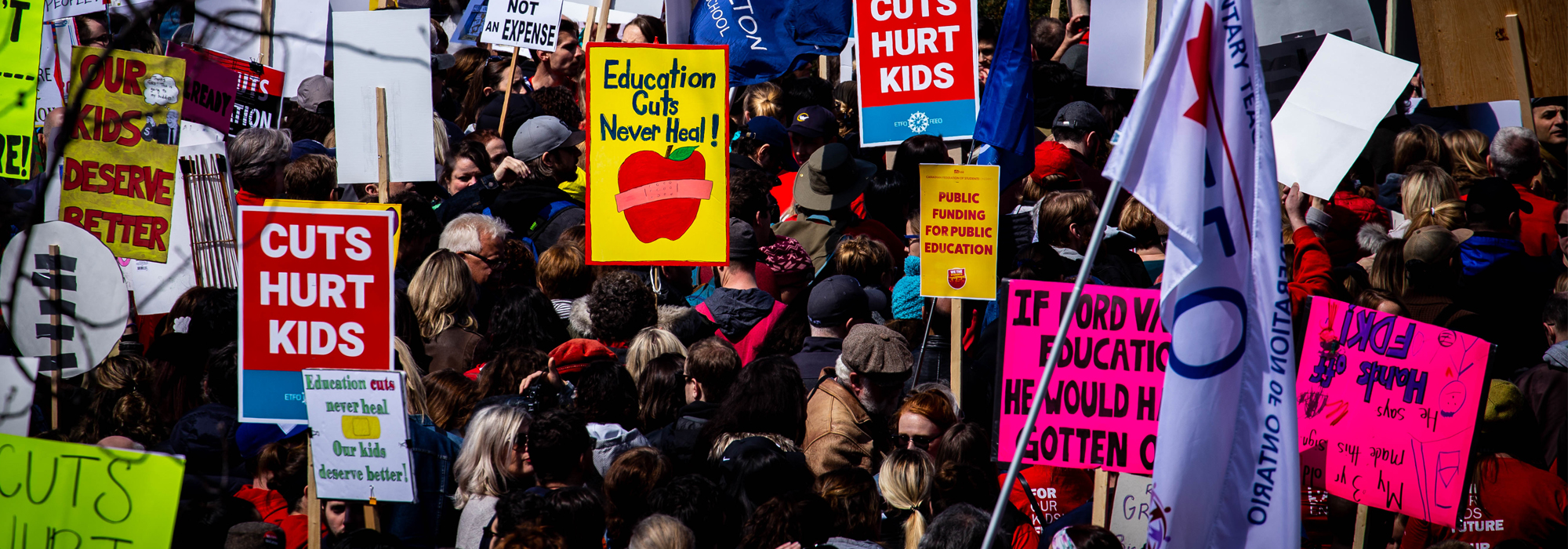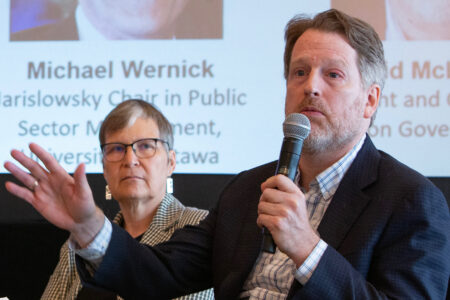
When General Motors announced the closure of its Oshawa plant in November 2018, newly elected Ontario Premier Doug Ford rejected calls for provincial help to save the jobs with the words “the ship has already left the dock.” For the premier of a one-time manufacturing heartland to make this claim was an indication that Ontario is now something different economically. It is worth asking whether it will also be something different in federal-provincial relations. Has the ship of being a moderating, consensus-seeking intergovernmental player also sailed?
The election of a Conservative government in Ontario in June 2018 has given rise to predictable policy choices, with cuts to programs and taxes, but it is harder to tease out the implications for intergovernmental relations. The federal government and intergovernmental relations were almost entirely absent from the Progressive Conservatives’ election platform, beyond anti-carbon tax rhetoric and calls for joint action on mental health. True, it was a thin platform by Canadian standards. However, before revelations of problematic conduct forced Patrick Brown to resign as PC leader in February 2018, the party released a very detailed platform document, the “People’s Guarantee,” that was likewise silent on intergovernmental questions.
The new government’s throne speech revealed no vision of Ontario within the federation, beyond reiterating its opposition to federal carbon pricing. By all indications, the Ford government will likely mark the broader Canadian landscape more by its indifference than by its participation.
An Inward Focus
There has never been an Ontario premier elected with so little political experience and so little knowledge of the provincial government as Premier Ford. The joke that Ford ran to be premier to be mayor of Toronto seems to have some truth given his move to change the size of Toronto city council in mid-election and to make the city’s subways a provincial responsibility. The premier has shown no signs of appreciating Ontario as a community engaged with other provincial communities in pursuing a pan-Canadian interest.
In its first year in office, the Ford government has brought forth ambitious plans for an in-depth restructuring of both the health care and secondary education systems, for the adoption of a performance model of university funding, for a billion-dollar cut to social assistance, and for downloading public health and childcare costs onto municipalities. In short, the government has decided to invest its energies in austerity projects posing significant bureaucratic/administrative challenges as well as predictable conflicts with a wide range of affected stakeholders. It is not a government that is looking to intergovernmental relations to meet its policy goals, nor one that has imagination or appetite for national conversations.
This contrasts with the past governments of Kathleen Wynne and Dalton McGuinty, where the intergovernmental realm was used to advance important election promises, particularly by trying to shift some costs and responsibility to the federal government. For instance, working with the federal government and the provinces to enhance the Canada Pension Plan fulfilled a promise to improve retirement security without the costs and administrative complications of creating a separate Ontario retirement plan. On childcare, poverty reduction, housing and infrastructure, the accomplishment of provincial promises relied on engaging the federal government to either partially fund or to supplement provincial priorities. For the Ford agenda, the federal role is not that relevant, either as an irritant or as a facilitator.
Looking Outward
An inward focus need not mean a full-scale retreat from the intergovernmental realm. The Mike Harris government elected in 1995 is comparable in the scale of its agenda of state reform, but it nevertheless did sustain more outward focus. The province contributed economist and scholar Thomas Courchene’s ACCESS paper to the intergovernmental discussions on social policy renewal. When the federal government unilaterally cut its transfers to provinces in an effort to balance its books, most visibly in the 1995 budget, Ontario was an active player in the provincial coalition seeking to create rules and processes that would renew the federal-provincial relationship on new grounds, which led among other things to the Social Union Framework Agreement of 1999. Harris appointed Diane Cunningham as Minister of Intergovernmental Affairs to lead this work.
By contrast, Ford has kept the intergovernmental affairs portfolio to himself. Beyond Ontario’s participation in challenging the federal carbon tax as unconstitutional, there has been little engagement with intergovernmental relations beyond punctual cooperation addressing issues as they arise. For instance, the need to undertake North American trade negotiations and develop a response to steel tariffs showed the capacity of the federal and Ontario governments to develop a common position in reaction to US President Trump’s trade maneuvers.
But in places like throne speeches or budgets, where Ontario could proactively set an agenda, we find very little. The 2019 Ontario budget called on the federal government to help fund specific transit infrastructure projects and to legalize single-event sports wagering. Beyond that, it reiterated the longstanding complaint that Ontarians pay $12.9B more in federal taxes than they receive in federal spending and called for a review of federal transfers.
There are nevertheless a few potential wildcards on the horizon. The heating up of anti-equalization rhetoric in Alberta and Saskatchewan places Ontario in an interesting position. The province has historically supported the equalization program, but the recent experience of Ontario being an equalization recipient, even as Ontarians are net contributors to the program, might make Ford a convert to a position like Saskatchewan’s “50-50” equalization plan, as Ontario would be a net beneficiary of that plan.
Similarly, the heating up of conflicts around the Canada Health Act between the federal government and Quebec provides an opening for Ontario to support its provincial neighbour, both on the grounds of the shrinking federal share of health spending as federal health transfers grow more slowly than provincial spending in the sector (mentioned in passing in the 2019 Ontario budget), and in terms of providing a freer hand to outsource and privatize when recrafting health care in Ontario.
This is not to predict the adoption of these positions. But it is to say that by temperament and by training, Premier Ford is less likely to embrace a vision of Ontario’s long-term interests relying on sustaining the norms of diffuse reciprocity – namely the idea that actors in intergovernmental relationships seek to make sure that beyond the winners and losers in specific negotiations, all parties benefit over the longer term. The premier’s threat to walk out of the November 2018 first ministers’ meeting unless the agenda was changed was not in keeping with the historic culture of federal-provincial interaction nor with Ontario’s traditional behavior.
The lack of a broader view of its interests nevertheless makes Ontario a fickle ally for other provinces. Take the climate change file. While Ford can find common cause with Alberta and Saskatchewan on the federal government’s current carbon pricing plan, Ford and Alberta Premier Jason Kenney are in a zero-sum game in any realistic national plan to meet Canada’s international obligations. The expansion of Alberta emissions is meant to be compensated for with larger than average efforts in Ontario and Quebec. Ford’s recent climate-change plan makes clear that Ontario’s ambition is to only cut to the level of the international commitment, and not to go further in order to “make space” for greater Alberta emissions.
Ontario and the 2019 Federal Election
While Ford has a weak sense of Ontario’s enduring interests, he does have a strong sense of partisanship. Whether the government is Conservative or Liberal after the election will affect not only the files on the agenda, but also Ontario’s stance. In the run-up to the October election, the federal party leaders must consider how they relate to Ford’s reform agenda. Platform policy choices on topics as varied as carbon pricing, refugees and childcare could provoke real-time reactions from the premier.
Federal Conservative leader Andrew Scheer’s criticisms of the government’s asylum policies and his recent foray against beer taxes indicate a desire to follow Ford’s successful courting of frustrated suburban working-class voters seeking a lower cost of living and a state upholding order and tradition. At the same time, Ford’s program of austerity has started to raise fears of job losses in the broader public sector, larger high school class sizes and higher property taxes (to fund downloaded services), which would affect those voters. This provides an opening for the Liberals or the NDP to make policy offers around childcare, transit, or access to postsecondary education, providing these voters with another path. The extent of change undertaken by Ford, despite a relatively centrist platform, could also make it more difficult for Scheer to get voters to trust him as a moderate alternative if he runs in a similar space.
As with intergovernmental relations, Ford’s lack of federal-provincial focus reduces Ontario’s bargaining leverage. The suburbs of Toronto swung to the Conservatives to elect Stephen Harper’s majority government in 2011 and then swung to elect a Liberal majority in 2015, and are crucial to the outcome in 2019. While some premiers might push federal parties to “bid” for their support by committing to a series of policy positions reflecting their province’s interests, Ford has chosen to share his political capital with Scheer. This is not so different from Kathleen Wynne, who stumped hard for the Liberals in 2015. But it is another sign that when it comes to Ontario as a provincial player with a longer-term view of its interests in the Canadian system, well, that ship has sailed, too.
This article is part of the Provincial Dynamics and the 2019 Federal Election special feature.
Photo: Shutterstock, by Alexander Gold
Do you have something to say about the article you just read? Be part of the Policy Options discussion, and send in your own submission. Here is a link on how to do it. | Souhaitez-vous réagir à cet article ? Joignez-vous aux débats d’Options politiques et soumettez-nous votre texte en suivant ces directives.









